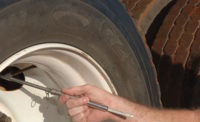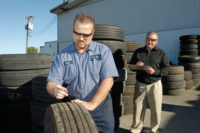Tire retreading saves on fleet maintenance costs
Many factors influence retreadability

As urban legends go, the belief that retreaded tires aren’t safe or practical ranks up there with the idea that one can find an honest politician during an election year.
The reality is that a retreaded tire produced by a top-quality retreader will perform as well as a comparable new tire and at a lower price. The cost of a retread typically is 30 to 50 percent less than a new tire, according to the Tire Retread & Repair Information Bureau (TRIB). Retreaded tires represent a savings of more than $3 billion annually for truck fleets, the bureau adds.
Retreads also are environmentally friendly. It takes approximately 22 gallons of oil to manufacture one new medium truck tire, according to TRIB. Most of the oil is found in the casing, which is reused in the retreading process. As a result, it takes approximately 7 gallons of oil to produce a retread, the bureau adds.
Tire & casing management is key
The lowest possible cost-per-mile is achieved with a good tire management program that includes the use of quality retreads.The number of times a tire can be retreaded depends on several factors, particularly the truck’s application. As a general rule, the faster the wear, the more times a tire can be retreaded. Running high-mileage line hauls, one to three retreads on a casing might be typical, but when running a lot of local miles, five or more retreads can be expected, provided that the tire isn’t lost as a result of casing injuries.
Many factors involved
There are several other considerations that go into determining whether a casing is fit to be retreaded, according to TRIB.
Retread considerations include the application in which the tire was used, the type of equipment on which the tire was and will be used, how well the tire was maintained and operated, the number of times the tire already has been retreaded, and the user’s specifications.
According to TRIB, a new tire in a service application with poor attention to equipment and tire maintenance can turn a tire “old” well before its time, making it unsuitable for retreading. Yet, a tire that is chronologically older, but has not been subjected to conditions that cause premature casing loss, likely can be retreaded multiple times.
Many factors influence the average life expectancy of a tire. Among them are weather and climate conditions, sitting for extended periods of time, the amount of weight on them and storage conditions.
When it comes to retreading, a casing six years old or older might be suspect. But in the final analysis, it is the retreader’s job to determine the retreadability of the casings.
Tire debris
The most common objection to retreads often involves the tire debris seen along the highways. However, retreads are not the sole cause of tire debris as it can just as easily come from tires that never have been retreaded.
The major causes of tire failure fall under the category of improper maintenance. Under-inflation is the biggest culprit, but mismatched tires in dual-wheel positions, running one tire flat on a dual-wheel assembly, misalignment, etc., all can cause tires to fail.
Additional saving strategy
One of the more unique strategies for using retreads to save even more on tire costs is practiced by Premium Beers of Oklahoma. Considering the size of its fleet, the company buys surprisingly few new tires. To do this, it supplements the purchase of approximately 60 new tires a year with another 60 or so new tires removed from the 10-12 new trucks it purchases each year.
The company orders its new trucks with all-position tires on every axle. Once it takes possession of a new truck, the tires and wheels are removed from the drive axle(s) and replaced with retreads already mounted on the fleet’s inventory of spare wheels. Virgin tires are reserved solely for steer axle use.
Once the steer axle tires have accumulated 40,000 to 50,000 miles, they are retreaded with an all-position tread pattern. The fleet will use about 140 retreaded tires in an average year. The retreaded tires are pulled for retreading or disposal once they are worn to a tread depth of no less than 3/32 of an inch. Unless the tire casings meet an early demise due to damage, each casing will be retreaded twice before being retired from service.
The newly retreaded tires are mounted on Premium’s spare wheels so that they are inflated with air and ready for tire changes in the shop or on a service call to one of the fleet’s trucks on the road. The reduction of downtime enabled by the quick “pit stop” turnaround of tire service calls does much to offset the cost of its spare wheel inventory.
Looking for a reprint of this article?
From high-res PDFs to custom plaques, order your copy today!




